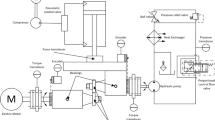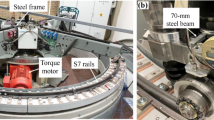Abstract
The forward slip coefficient is one of the most important parameters for heavy rail rolling using universal mill. For simplifying the theoretical model, the vertical roll with box pass was simplified as an equivalent flat roll first, Second, the neutral angle of horizontal roll and vertical roll was represented. Then, the equation of neutral line on the flank of horizontal roll was determined and the forward slip coefficient of the web was derived according to different positions of neutral line. Finally, the forward slip coefficient of the top and base of heavy rail was obtained. The theoretical results were basically in agreement with the experimental data.
Similar content being viewed by others
Abbreviations
- Δb:
-
Maximum spread of rail top
- B0, Bk:
-
Minimum and maximum width of roll throat, respectively
- B w :
-
Width of web of heavy rail
- D h :
-
Diameter of horizontal roll
- D VB :
-
Diameter of vertical roll for rolling base of heavy rail
- D̅VT:
-
Equivalent diameter of vertical roll for rolling base of heavy rail
- f h :
-
Friction coefficient between web and horizontal roll
- f hh :
-
Friction coefficient between the rail base and the flank of horizontal roll
- f ht :
-
Friction coefficient between the rail top and the flank of horizontal roll
- f vb :
-
Friction coefficient between rail base and vertical roll
- f vh :
-
Friction coefficient between the vertical roll and the flank of horizontal roll
- f vt :
-
Friction coefficient between rail top and vertical roll
- G h :
-
Gap of horizontal roll for rolling top of heavy rail
- Gvb, Gvt:
-
Gap of vertical roll for rolling base and top of heavy rail, respectively
- G̅vt:
-
Equivalent gap of vertical roll for rolling top of heavy rail
- H f :
-
Height of box pass
- Lb, Lt:
-
Length of deformation zone for rolling base and top of rail, respectively
- L w :
-
Length of deformation zone between horizontal roll and web of heavy rail
- p̅h:
-
Mean unit pressure acting on web from horizontal roll
- p̅vtp̅vb:
-
Mean unit pressure acting on top and base of rail from vertical roll, respectively
- p̅htp̅hb:
-
Mean unit pressure acting on top and base of rail from flank of horizontal roll, respectively
- R0b, R0t:
-
Equivalent radius of bearing of vertical roll for rolling base and top of heavy rail, respectively
- R h :
-
Radius of horizontal roll
- Rvb, Rvt:
-
Radius of vertical roll for rolling base and top of heavy rail, respectively
- R̅vt:
-
Equivalent radius of vertical roll for rolling base of heavy rail
- v h :
-
Linear velocity of horizontal roll
- v vt v vb :
-
Linear velocity of vertical roll for rolling top and base of heavy rail, respectively
- W0, Wf:
-
Minimum and maximum width of box pass, respectively
- W t :
-
Weighting function of α
- WT0, WT1:
-
Width of incoming and outgoing work-piece, respectively
- αh:
-
Bite angle of horizontal roll
- αvb, αvt:
-
Bite angle of vertical roll for rolling base and top of heavy rail, respectively
- μ0b, μ0t:
-
Equivalent friction coefficient of bearing for rolling base and top of heavy rail, respectively
References
KIUCHI Manabu, YANAGIMOTO Jun. Computer Aided Simulation of UniversalRolling Processes [J]. ISIJ Int, 1990, 30(2): 142.
Kazutake Komori, Katsuhiko Koumura. Simulation of Deformation and Temperature in Multi-Pass H-Shape Rolling [J]. J Mater Proc Tech, 2000, 105(1-2): 24.
IKUTA Kazushige, AOYAGI Koshiro, KAWANAMI Takao. Calculation Method of Loads on Skew Roll Mill for Web Expansion of H-Beam [J]. ISIJ Int, 1995, 35(9): 1089.
ZHAO Sun-jun. The Discussion About the Forward-Slip in H-Beam Rolling by Universal Mill [J]. Xian Met Architecture Institute, 1982, 12(6): 68 (in Chinese).
WANG Zhe. Deformation Character and Force-Energy Parameter of Rolling H-Beam [D]. Qinhuangdao, China: Yanshan University, 1984 (in Chinese).
JIN Xiao-guang. Experimental and Theoretical Study on the Continuous Rolling Process of H-beam [D]. Qinhuangdao, China: Yanshan University, 1990 (in Chinese).
Zhang W, Zhu C, Widera G E O. Determination of Forward Slip in H-Beam Rolling [J]. J Mater Proc Tech, 1995, 54(1-4): 114.
Lee Y, Choi S. New Approach for the Prediction of Stress Free Surface Profile of a Workpiece in Rod Rolling [J]. ISIJ Int, 2000, 40(6): 624.
Lee Y. An Analytical Study of Mean Roll Radius in Rod Rolling [J]. ISIJ Int, 2001, 41(11): 1414.
Dong Y, Zhang W, Song J. A New Analytical Model for the Calculation of Mean Roll Radius in Round-Oval-Round Alloy Bar Rolling [J]. ISIJ Int, 2006, 46(10): 1458.
Dong Y, Zhang W, Song J. A Novel Approach for the Prediction of Surface Profile of Outgoing Workpiece and the Calculation of Mean Roll Radius in Alloy Bar Rolling [J]. Acta Metallurgica Sinica (English Letter), 2007, 20(1): 49.
BAI Guang-run. The Pass Design of Strctural Sections [M]. Beijing, China: Metallurgical Industry Press, 1995 (in Chinese).
XUE Yi-de, GAO Chun. The Press Working of Special Steel [M]. Beijing, China: Metallurgical Industry Press, 2000 (in Chinese).
Author information
Authors and Affiliations
Corresponding author
Rights and permissions
About this article
Cite this article
Dong, Yg., Zhang, Wz. & Cao, H. Determination of Forward Slip Coefficient During Heavy Rail Rolling Using Universal Mill. J. Iron Steel Res. Int. 15, 32–38 (2008). https://doi.org/10.1016/S1006-706X(08)60027-8
Revised:
Published:
Issue Date:
DOI: https://doi.org/10.1016/S1006-706X(08)60027-8




